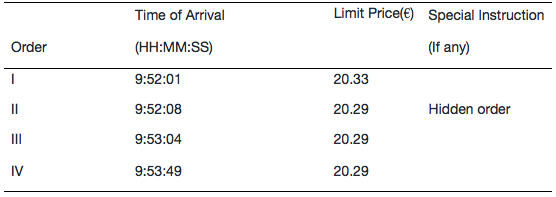NO.PZ2015122802000033
问题如下:
Consider an order-driven system that allows hidden orders. The following four sell orders on a particular stock are currently in the system’s limit order book. Based on the commonly used order precedence hierarchy, which of these orders will have precedence over others?

选项:
A.Order I (time of arrival of 9:52:01).
B.Order II (time of arrival of 9:52:08).
C.Order III (time of arrival of 9:53:04).
解释:
C is correct.
Order III (time of arrival of 9:53:04) has precedence. In the order precedence hierarchy, the first rule is price priority. Based on this rule, sell orders II, III, and IV get precedence over order I. The next rule is display precedence at a given price. Because order II is a hidden order, orders III and IV get precedence. Finally, order III gets precedence over order IV based on time priority at same price and same display status.
考点:隐藏订单
隐藏订单通常是一些规模较大的订单,只暴露给接收它们的经纪人或交易所,而不显示在公开的报价单中。
隐藏订单成交优先级只有一种顺序:1、第一价格优先 2、第二显示优先(如果价格相同,非隐藏优先)3、第三时间优先
订单簿中给出的是四个卖单,那么根据成交优先级先看价格,卖的越便宜越先成交,所以I先排除,再看订单的是否显示, III和 IV是非隐藏订单,所以排除II。最后再看时间 III比IV报的时间早,所以 III最先成交。
在学习这一个Reading(R33)的时候,好多题目中的知识点老师在授课的视频中并没有提及,比如本体的隐藏订单,或者有些名字看上去很熟但是课程里也没有细讲,就导致做题的时候很懵,请问我是要去看电子原版书吗,还是有什么学习方式来解决这种情况?
另外,针对本题,在看哪个order优先的时候是不是都遵循价格优先然后如果价格相同再看时间优先的原则?



